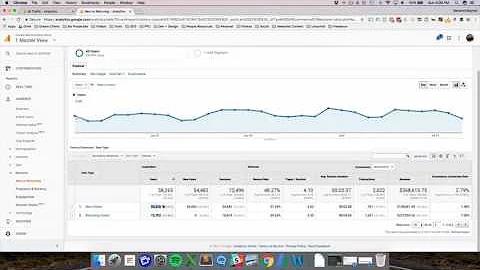Google Analytics - User vs New Visitor vs Returning Visitor
Solution 1
Sometimes Google Analytics metrics can be tricky to understand, but there are a few places where you can get more info about it, namely:
- Google Analytics Developers API
- Analytics Help - Metrics and Dimentions, here
Directly replying to your question, here's what you'll want to know while quoting this article here:
User: The total number of users for the requested time period.
New User: The number of users whose session was marked as a first-time session.
Visit (now session count): The session index for a user. Each session from a unique user will get its own incremental index starting from 1 for the first session. Subsequent sessions do not change previous session indices. For example, if a user has 4 sessions to the website, sessionCount for that user will have 4 distinct values of ‘1’ through ‘4’.
So: User = unique people who visited your site
New / Returning = Ratio between new users and people that had already visited your page
Session Count = The number of times users came to your site opening a session (doesn't matter if it's new or returning).
If the numbers don't add up, give GA a few more hours, it can happen the calculations take a bit to come off.
Solution 2
A user is identified by a long term cookie. A user is typically a person on a particular device. The same person would not become a new new user unless they switched devices (tablet to phone to computer, etc), switched browsers, entered private browsing, or cleared their cookies. Two people would usually not be identified as the same user unless they shared the same computer, login, and browser.
A visit is identified by a short term cookie. Visits time out after 30 minutes of inactivity (by default, although this is a setting in your GA account).
When Google Analytics says "new visitors" or "returning visitors", they mean "visits by new users", or "visits by returning users". For example user A has visited your site before today and user B is new. Each visits 2 times on the same day separated by at least 30 minutes:
- User A
- Visit 1: Returning user, Returning visitor
- Visit 2: Returning visitor
- User B
- Visit 1: New user, New visitor
- Visit 2: Returning visitor
You will have:
- 2 Users
- 1 New User
- 1 Returning User
- 4 Visitors
- 1 New Visitors
- 3 Returning visitors
New users will always be the same as new visitors, but each user may may multiple visits so the total number of visitors may be greater than the total number of users. Similarly, returning visitors may be greater than the number of returning users.
Related videos on Youtube
Windbrand1
Updated on September 18, 2022Comments
-
Windbrand1 over 1 year
In the Google Analytics audience overview report, I see "users" as 145, however in the audience -> behaviour -> new vs returning report, I see "new visitor" as 98 and "returning visitor" as 53.
This is highly confusing:
- What exactly is difference between "user" and "new/returning visitor"?
- If there were 145 "users", and "98 new users", then I assume there were 47 "returning users"??
- Users: 145
- New users: 98
- Returning users: 47
- New visitors: 98
- Returning visitors: 53
-
sally smith over 7 yearsThe cookie that identifies a returning user lasts for 2 years on one device - provided that the user doesn't clear cookies (and obviously, is still using the same device)
-
Steve Ransom about 6 yearsI still don't understand the difference between a returning user and a returning visitor. I think this is what the initial question was asking. I understand the different between a "visit" and a "user" (one is the act, the second is the person) but analytics seems to have two types of people it refers to, a "visitor" and a "user". And this is where the numbers don't ad up, so clearly they are no the same thing. Every article I read addresses what a "visit" is (the action) but I can't get clarification on what a "visitor" (the person) is.
-
 Stephen Ostermiller about 6 years@SteveRansom I added a new answer for you
Stephen Ostermiller about 6 years@SteveRansom I added a new answer for you
-
Windbrand1 over 7 yearsHi, thanks for the explanation. However I've been watching this page for many days now and the "user" count never equals "new visitor" + "returning visitor" so I highly doubt it's due to GA time delay. Also, from a logical perspective, shouldn't "user" simply equal "new visitor"? Because every user was a new visitor at some point in time right (I have my data time range set to beginning of inception to current day)?
-
 nunorbatista over 7 yearsHi @Windbrand1. No, GA counts the visits by setting a cookie on the user browser, so a user visits your site for the first time and that cookie is set = 1 user, 1 New User and 1 visit. The second time the same user comes, you'll have no change on the User metric, no change on the new User and one add on the Returning User and one add to the visit. Regarding the numbers not adding up: Google Analytics also count new users as returning users if they return within the selected time period, read more here bit.ly/1TeNPIL
nunorbatista over 7 yearsHi @Windbrand1. No, GA counts the visits by setting a cookie on the user browser, so a user visits your site for the first time and that cookie is set = 1 user, 1 New User and 1 visit. The second time the same user comes, you'll have no change on the User metric, no change on the new User and one add on the Returning User and one add to the visit. Regarding the numbers not adding up: Google Analytics also count new users as returning users if they return within the selected time period, read more here bit.ly/1TeNPIL -
alds over 7 years@nunorbatista. Thanks for explanation and referred articles especially to your comment above. My question, is, how about if a user has prior session/cookie from a non-included reporting period? For example, he has a session/cookie in 2016 and you're looking at stats for 2017 only. Will he be counted as a new user in 2017 when he visits for the first time that year or is he already a returning visitor?
-
 nunorbatista over 7 years@alds it doesn't matter if the reporting period is X-Z and the user set the cookie before. You'll see your user in the X-Z report as returning, even if the first cookie was set in 2016. There's some good reading about that in the comments of this article: e-nor.com/blog/google-analytics/…
nunorbatista over 7 years@alds it doesn't matter if the reporting period is X-Z and the user set the cookie before. You'll see your user in the X-Z report as returning, even if the first cookie was set in 2016. There's some good reading about that in the comments of this article: e-nor.com/blog/google-analytics/… -
alds over 7 yearsThanks and another good article cited! My question was in fact answered within the article and its example at the end
-
 Uğur Dinç about 4 yearsThank you for this! Wasn't aware that 30mins was a setting in Admin!
Uğur Dinç about 4 yearsThank you for this! Wasn't aware that 30mins was a setting in Admin! -
 Ben about 4 yearsHmm, if this is true, shouldn't New Visitors + Returning visitors = Number of sessions? That doesn't seem to hold true in my data.
Ben about 4 yearsHmm, if this is true, shouldn't New Visitors + Returning visitors = Number of sessions? That doesn't seem to hold true in my data.
![New Visitors Vs Returning Visitors Google Analytics [Complete Guide with Examples]](https://i.ytimg.com/vi/RzgtHY-jDCM/hq720.jpg?sqp=-oaymwEcCNAFEJQDSFXyq4qpAw4IARUAAIhCGAFwAcABBg==&rs=AOn4CLBXbWspv6yVEuJqYGTV3_9L0c7Tog)



